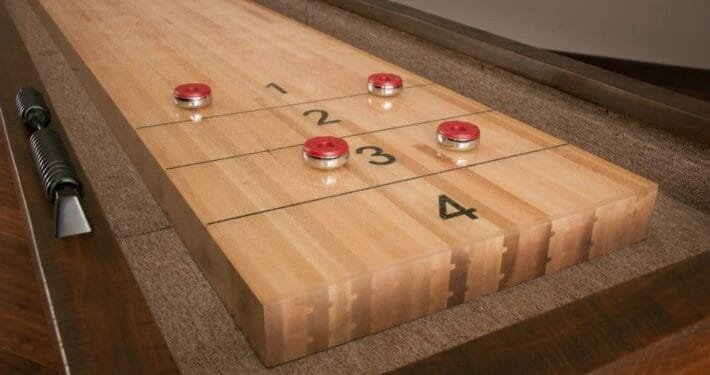Shuffleboard is a game in which players push a weighted disc down a narrow court. And to score a point, a disc must land in a scoring area marked on the board. As you can read in this source, several versions of this game exist.
This originally was a land game. Nowadays, it has ‘moved’ indoors, so now you can see shuffleboard tables in homes, bars, and even offices. People enjoy playing this relaxing game in any setting, so if you think of getting one of these for your house or office, you could use some handy guidelines.
When you buy shuffleboard, there are many factors to consider. For instance, the playfield size, materials, outer cabinet structure, etc. Knowing these will help you determine which game table is right for you. Only that way can you ensure hours of fun and spend quality leisure time.
Size
As with any purchase, you should start this one by knowing what you need. And when you’re in the market for a shuffleboard gaming system, you’ll need to determine the table size that will suit the playing area.
For example, the regular dimensions are 22 feet in length by 20 inches in width. Recreational boards can be shorter, ranging from 9 to 22 feet in length. But, of course, knowing where the shuffleboard will be set comes first.
In most cases, you should allow at least two feet of clearance all around it. There should be enough room around the table for players to stand and shoot. Besides, some cabinets may require more space to install the electronic score units.
A smaller table might be an excellent option if you are a new player. It’s easier to clean and maintain than a monster board and better suited to casual play. But if you plan to play shuffleboard frequently, larger play setting will provide a more challenging game.
Playfield Materials

The materials of the playfield can greatly affect the style of play. For example, their weaving dictates puck speed, direction, and ease of sliding. Also, these materials come in different qualities and price ranges, so determine your needs and budget before buying.
For instance, a premium table has a solid hardwood playfield, which is durable and scratch-resistant. And that’s more important than having a smooth, shiny playing surface that gets damaged in no time. That’s usually the case with cheaper materials and softer woods. But manufacturers work that out by reinforcing these materials with polymer coating.
Outer Cabinet Structure
The outer cabinet structure of a shuffle board is the key component that holds it together. As said, it’s usually made of solid hardwood. That adds weight to the structure and helps it stay in place even during intense matches. In most cases it’s maple, but it can be oak and mahogany.
Some brands specify the material of their cabinet structure right in the product name, while others only display the wood type and finish. Still, regardless of the material, you should always choose a durable outer cabinet to increase its longevity and provide years of worriless playing.
On the following page, you can find some instructions on building DIY shuffleboard table:
https://www.littleloveliesbyallison.com/diy-shuffleboard-table/
Cuts and Finishes
The surface where pucks slide is made of wooden pieces called a plank. These have been cured and treated to improve durability and resistance to friction. Plank layers contribute to playing surface thickness (the best ones are about 3” thick).
Plank layers are then covered with a clear resin finish, which reduces friction and adds a shiny, reflective finish to the table. Alternatively, if you’re looking for a cheap, durable option, consider choosing softwoods topped with lacquers and shellacs.
Climate Adjusters
Most shuffleboard tables are made of hardwood. Since this material expands and contracts during warm and humid weather, it can warp and become misaligned. That affects puck speed and accuracy. That’s why these tables need climate adjusters to ensure optimal play conditions.
If you’re not familiar with climatic adjusters, you can find them on most shuffleboards. They are typically bolted to the bottom of the board. Some shuffle-boards have as many as four or six adjusters per board. And their role is to prevent playfields from being warped or bumpy by adjusting their tension.
Shuffleboard climatic adjusters work by creating the perfect playing surface. They should be spaced at least three to four feet apart for optimal results. And when set properly, these adjusters can make a world of difference in the playfield. Buying a suitable shuffleboard table can be tricky if you don’t know what to look for. Well-made tables have features that set them from poor-quality tables. And you can feel the difference in puck hitting and sliding. So it’s good to learn some things about these tables and get the best one for your money.






















































